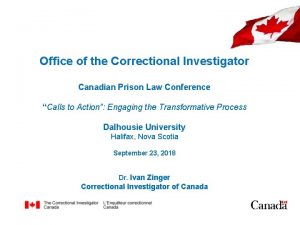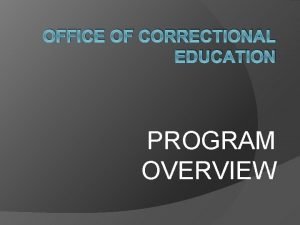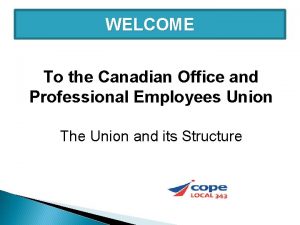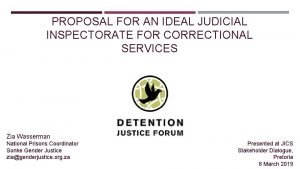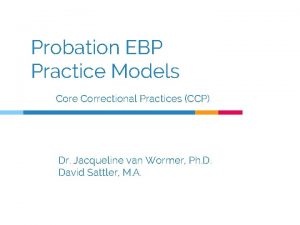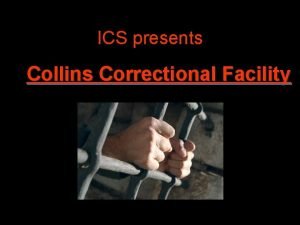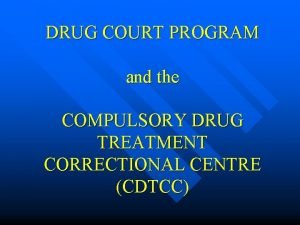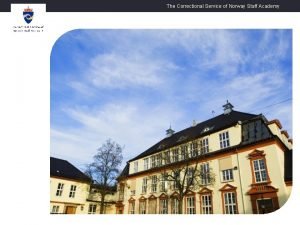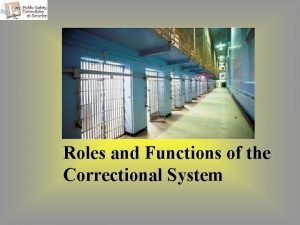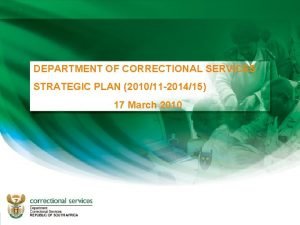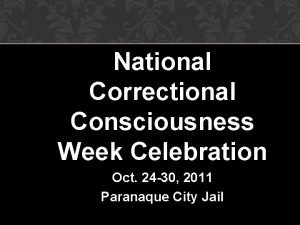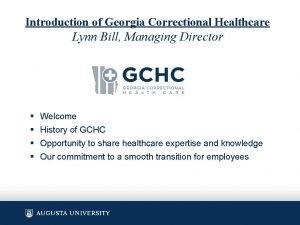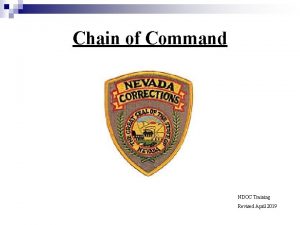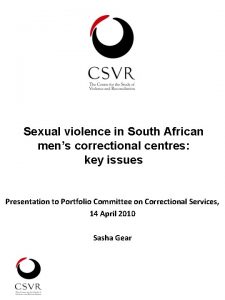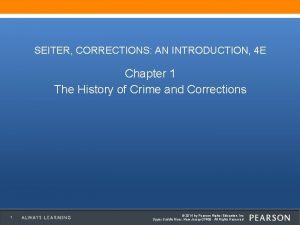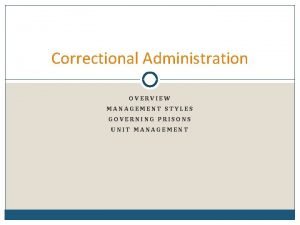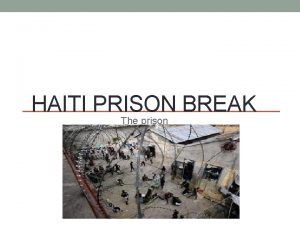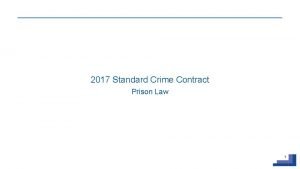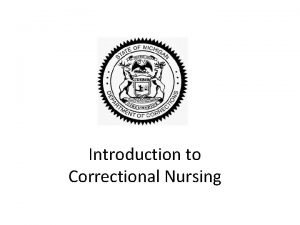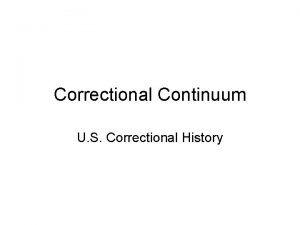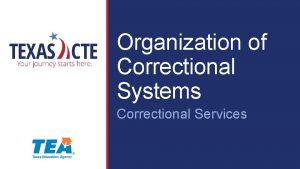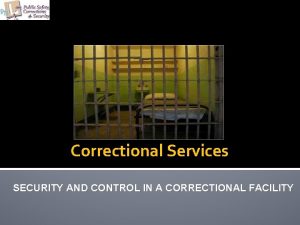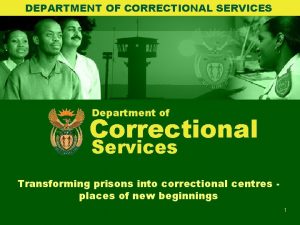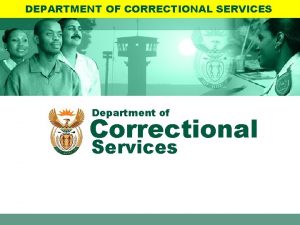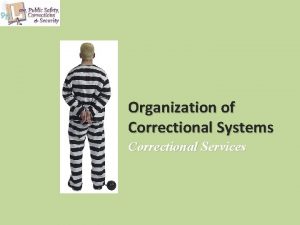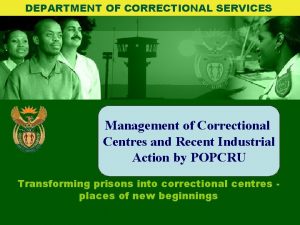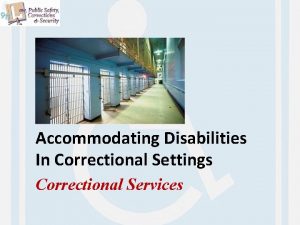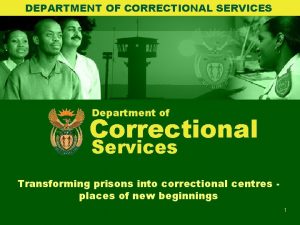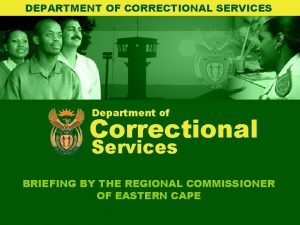Office of the Correctional Investigator Canadian Prison Law

















- Slides: 17

Office of the Correctional Investigator Canadian Prison Law Conference “Calls to Action”: Engaging the Transformative Process Dalhousie University Halifax, Nova Scotia September 23, 2018 Dr. Ivan Zinger Correctional Investigator of Canada

Office of the Correctional Investigator Role and Mandate • Ombudsman for federally sentenced offenders • Independent oversight of federal corrections • Conducts investigations into the problems of offenders related to “decisions, recommendations, acts or omissions” of the Correctional Service of Canada • Focus is on compliance, fairness and legality 2

Top Complaints by Category: Indigenous FY 2017 -18 3

Overrepresentation is Increasing Indigenous population in Canada: 4. 9% Current Status in Federal Corrections: 28% of federal inmates are Indigenous. 40% of in-custody women are Indigenous. • Indigenous offenders represented 30% of all admissions to federal custody in 2017 -18. The proportion entering the federal system is greater than the existing representation. • Most Indigenous offenders are released at their statutory release dates, at a rate of 72. 5%, compared to 60% for the overall population. Later releases = greater representation of Indigenous population inside prison. • All signs point to this trend continuing… unless something changes. 4

Correctional Outcome Indicators Compared to non-Indigenous Offenders § Incidents of self-injury o Indigenous inmates accounted for 48. 3% of all self-injury incidents in 2017/18 § Segregation o In 2017 -18, Indigenous offenders comprised 36% of all segregation admissions § Use of force incidents o In 2017 -18 , 47% of incidents involved at least one Indigenous inmate § Maximum security o A higher proportion (18. 3% vs. 14. 0%) are classified as maximum security (Public Safety, 2018, in press) § Gang affiliation o Over 20% Indigenous inmates are gang-affiliated (compared to 9% for non-Indigenous) § Community supervision o Day parole rates remain far below those for the overall population (18% vs. 35. 4%) o More often returned to custody on a revocation (39% vs. 31%) 5

Indigenous Social Histories and the Criminal Justice System § More likely to be serving a Schedule 1 (violence) offence. § Other family members likely to have spent time in prison. § Over half attended or had a family member attend a residential school. § Significant involvement with child welfare system. § 80% report no high school diploma at admission. § Alcohol and/or drug use part of offence cycle for vast majority. § Higher prevalence of Hepatitis C and HIV infection. 6

Federally Incarcerated Indigenous Women Indigenous: 43 Indigenous: 163 Indigenous: 43 Indigenous: 12 Indigenous Women Incarcerated = 265 (38%) Supervised in community= 185 (27%) Source: Corporate Reporting System, November 2017 7

Indigenous Women in Federal Custody Sentence characteristics of Indigenous women compared to non. Indigenous women: § Tend to be younger (average of 34 years versus 38). § More likely to be serving a Schedule 1 (violence) offence (58% versus 32%). § More likely to be gang affiliated (10% versus 0. 9%). § Tend to have lower levels of education at admission. 8

Indigenous Women in Federal Custody Social Histories § Over half attended or had a family member attend a residential school. § Nearly half were removed from family home (e. g. adopted, foster care, or group home). § Almost all indicate report past traumatic experiences (physical or sexual abuse), and substance use history. § High rates of involvement in prostitution at an early age. § Almost half (47%) indicated a history of injection drug use. 9

Indigenous Women in Federal Custody Correctional outcomes compared to non-Indigenous women: § Over-represented in: § § Incidents of self-injury. Segregation. Use of force incidents. Maximum security. § Assessed as higher risk, more likely to break institutional rules. § Less frequently granted day or full parole, and more likely to be returned to custody (suspension and revocation). § More likely to be released at Statutory Release (2/3 sentence). 10

Truth & Reconciliation: Six “Calls to Action” Impacting Federal Corrections 1. Commit to eliminating the overrepresentation of Aboriginal people in custody over the next decade. 2. Provide sufficient and stable funding to implement and evaluate community sanctions that will provide realistic alternatives to imprisonment. 3. Undertake reforms to the criminal justice system to better address the needs of offenders with Fetal Alcohol Spectrum Disorder. 4. Eliminate barriers to the creation of additional Aboriginal healing lodges. 5. Work with Aboriginal communities to provide culturally relevant services to inmates. 6. Provide more supports for Aboriginal programming in halfway houses and parole services. 11

Commissioner’s Mandate Letter: Highlights • Work with Indigenous partners to increase the number of community-run healing lodges established under Section 81 of the CCRA, as well as the number of community-supported releases under Section 84. • Ensure that Indigenous offenders have timely access to effective, culturally-appropriate interventions developed in collaboration with Indigenous partners, so as to prepare them for successful and timely conditional release. • Address the particular needs of Indigenous women within the correctional system. • In consultation with Indigenous partners, re-examine CSC's governance structure and the role of the National Aboriginal Advisory Committee in order to ensure greater integration of Indigenous needs and perspectives into CSC decisions at the senior level. 12

Directions for Reform 1. Significant reallocation of CSC resources to community corrections and alternatives. • Private home placements using sponsors and compensation for sponsorship: solution for immediate bed space challenges. Increase use of true section 84 releases. • Enhance Section 81 partnership and capacity in urban centres (many Indigenous people are released to cities). 13

14

Directions for Reform 2. National Leadership & Government Direction • Time is of the essence! • Appoint a Deputy Commissioner for Indigenous Corrections to ensure corporate priority and accountability, and strengthen role of National Aboriginal Advisory Committee. • Develop community options and placements now. • Additional legislative reform to reducing over-representation? • Honour TRC commitments, including annual public reporting on progress in reducing over-representation. 15

Directions for Reform 3. Administration of the sentence • Meaningful application of Gladue factors. • Develop partnerships with Indigenous communities (funding parity between section 81 and CSC Healing Lodges). • Provide Indigenous communities greater autonomy to decide level of care and intervention required. • Balancing institutional vs. community corrections (funding and alternatives). • More access to Elders and better defined roles and workloads. • Programming and services which are more responsive to unique needs and circumstances, including core programming, gang disaffiliation, life skills, education and vocational training. • Address over-representation of secure units for Indigenous women. 16

“It is said that no one truly knows a nation until one has been inside its jails. A nation should not be judged by how it treats its highest citizens, but its lowest ones. ” - Nelson Mandela WWW. OCI-BEC. GC. CA 17
 Office of the correctional investigator
Office of the correctional investigator Office of correctional education
Office of correctional education Canadian office and professional employees union
Canadian office and professional employees union Pcfio
Pcfio Correctional nursing
Correctional nursing Core correctional practices
Core correctional practices Criminal justice corrections
Criminal justice corrections Collins correctional facility
Collins correctional facility Compulsory drug treatment correctional centre
Compulsory drug treatment correctional centre University college of norwegian correctional service
University college of norwegian correctional service 3rd degree felony
3rd degree felony Department of correctional services strategic plan
Department of correctional services strategic plan National correctional consciousness week
National correctional consciousness week Susan norton augusta university
Susan norton augusta university Correctional officer rank structure
Correctional officer rank structure Sexual harassment cases in correctional centres
Sexual harassment cases in correctional centres Correctional funnel
Correctional funnel Leadership styles in correctional facilities
Leadership styles in correctional facilities
